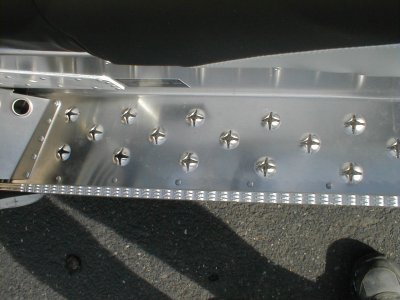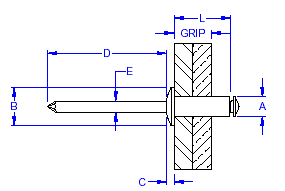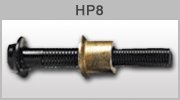Rivets, or better known as "pop-rivets" have been around a long time, however the author hasn't been in tune, until recently.
A pop rivet gun is an inexpensive and easy-to-operate tool that is a welcome addition to any shop.
For repairing gutters, window screens, sheet metal pipe or any of the other light-gauge metal components around the house, you'll quickly find it indispensable.
A pop rivet gun looks something like a large pair of pliers.
There are two handles – one fixed and one movable – and a metal head with interchangeable riveting inserts that will accommodate different sizes of rivets.
The pop rivet itself looks something like a nail with a flanged metal sleeve over one end. In use, the gun pulls up on the "nail" end of the rivet – the shaft –
causing the sleeve end, which is the actual rivet, to expand and lock the two pieces of metal together.
When the force being exerted on the rivet by its expansion exceeds the breaking point of the slender shaft, the shaft snaps off and leaves the rivet in place.
It's the distinctive sound of the shaft snapping away that gives the "pop" rivet its name.
Unlike screws, pop rivets are permanent once they're installed. They should not be used for joining parts that will need to be disassembled again.
How It's Used
Pop rivets come in different lengths and diameters, depending on what you want to rivet.
Because the rivet will only expand so far before snapping, you need to make sure that you select a length that is compatible with the combined thickness of the pieces you are
joining – a chart that accompanies the rivets helps you with the selection.
The rivets are also available in both steel and aluminum, allowing you to select one that's compatible with the type of metal you wish to join.
First, align and temporarily clamp the two pieces of metal to be joined. Using the drill bit selection guide supplied with the rivets, drill a hole of the proper diameter
through both pieces.
Next, select the insert that corresponds to the diameter of the rivet you're using, and insert it into the rivet gun.
Insert the pop rivet into the hole in the metal being joined until the flange is completely up against the surface, then slip the gun over the shaft end of the rivet.
If it's easier, you can also do this in the reverse order by putting the rivet into the gun first.
Squeeze the handles on the gun gently to begin putting pressure on the rivet, and double check that everything is aligned how you want it.
Remember – pop rivets are not designed to be removable. Once the rivet is installed, the only way to get it out again is to drill out the core of the rivet or grind off the
head on one side so that the rivet can be driven out.
Continue to squeeze the handles firmly as the rivet expands in the hole. You will see the metal draw together as the end of the rivet opposite the flange continues to
flatten out and enlarge. After a couple of squeezes on the handle the rivet will be fully expanded, and the shaft will snap off from the rivet and remain in the gun.
Finally, pull the shaft out of the gun and discard it, and you're ready to install another rivet.
Pop rivet guns and replacement rivets are sold in home centers, hardware stores, and many other retail outlets.
For your initial purchase, look for a complete kit that contains the gun, inserts, insert wrench, and a selection of rivets. If you have a lot of similar riveting to do –
installing a gutter system, for example – you can purchase rivets of the same size by the box.
To have handy in your toolbox, however, your best bet is to buy a rivet selection that includes several sizes in both aluminum and steel.
The rivet gun will come with complete instructions, and they need to be followed carefully. Also, you should always wear eye protection and follow any other
safety precautions recommended by the manufacturer.
For this city it's a small nightmare trying to find the correct size over the weekend, where the usual utility type places are closed, so one is stuck with the usual retail
places that "sorta" carry most item, but not all, such as the one size of 3/16" x 1" with a large head, being looked for.
That's another reason a lot of people shop over the internet (gee that's why your here, right?) for information, products and communication (email/PM).
It's a changing world whether we like it or not, that's the way it is.
The two common metal types of steel and aluminum, however are available in copper, stainless and nickel-copper as well. This give a choice if metal galvanic corrosion is
a consideration from dis-similar metals, plus, and "electrolyte" involved, such as in marine uses.
Diameter sizes range from:
3/32"
1/8"
5/32"
3/16"
1/4"
They also come in several different lengths, which is just as important as the diameter size. The brand "Arrow" is good, however has an annoying package description as
"Short"
"Medium"
"Long"
This kind of thing had the author going around in circles in town with a learning curve.
Other brands spec the lengths in either inches or millimeters, and mostly are 1/4", 3/8", 1/2" or 5/8". Those specs are the maximum length needed to fasten a hole depth.
Obviously, you can use long ones for shallower holes (see picture, blow), but requires more (unnecessary) pumping of the tool and might have a clearance issue in some machinery
such as a sled's tunnel, as shown (on the outside) below.

Different types of rivets

 |
Open End- Wide POP rivet range. Providing strong, low cost fastenings, open-end rivets are ideal for a wide variety of applications.
Aluminum
Steel
Stainless
Nickel-Copper
Copper |
 |
Closed End- Where fastenings have to be water or pressure tight, and 100% mandrel head retention is required. |
 |
Soft Set - Soft-Set POP Rivets incorporate a body and mandrel of special aluminum alloys. |
 |
MultiGrip- Wide grip range, ideal for use in inconsistent holes, reduced rivet inventory. |
 |
UltraGrip - Provide superior holding power over other high strength rivets. |
 |
T-Rivet - Designed for structural and similar high strength applications. |
 |
Large Secondary Head - Rivet Designed especially for plastics and other brittle or soft materials. |
 |
Easy Entry - Easy Entry Rivets line up odd shaped or misaligned holes in multiple sheets of material to make production easier and faster. |
In 2006 the author discovered and tried a new type of "rivet" called "Hucks". It's pretty much the same, but much stronger. Here's a couple examples of what they look like.
Do a google search for the word Huck rivets and you'll find sources. To install these guys, will take a special tool.


![[Karl's sled page]](images/winter_home3.gif)












![[Karl's sled page]](images/winter_home3.gif)